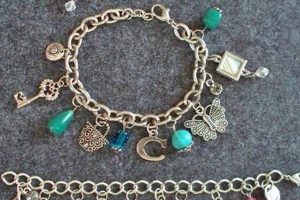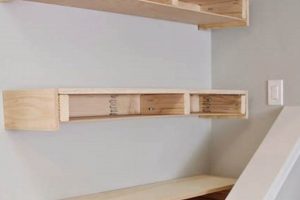The creation of window coverings, characterized by fabric that folds neatly upon raising, through individual effort is a popular home decor endeavor. This process involves selecting fabric, measuring the window dimensions, and employing sewing techniques to construct functional and aesthetically pleasing window treatments.
This hands-on approach to window treatment design allows for personalized customization to match specific interior design schemes and budgetary constraints. Historically, crafting personal window furnishings offered cost savings and creative control. The practice continues to provide empowerment and a sense of accomplishment for homeowners.
A detailed examination of fabric selection, measurement accuracy, construction methods, and installation techniques will follow, providing a comprehensive guide to successfully producing these custom window coverings.
Essential Considerations for Crafted Window Coverings
The following guidance focuses on achieving optimal results when constructing fabric-based window coverings that fold upwards upon raising. Careful planning and execution are crucial for both functionality and visual appeal.
Tip 1: Fabric Selection is paramount. Choose a medium-weight fabric that drapes well and offers the desired light control. Consider lining the shade with blackout fabric for enhanced privacy and light blockage.
Tip 2: Accurate Measurements are essential. Measure the window opening precisely, accounting for inside or outside mount preferences. Inaccurate measurements will result in ill-fitting shades.
Tip 3: Employ Precise Cutting Techniques. Use a rotary cutter and self-healing mat to ensure clean, straight fabric cuts. Accurate cutting contributes significantly to the final product’s appearance.
Tip 4: Reinforce Stress Points. Securely stitch all seams and attachment points, particularly where rings are attached for lifting. Reinforcements prevent tearing and ensure durability.
Tip 5: Maintain Consistent Ring Spacing. Evenly space the rings along the back of the shade to ensure uniform folding. Inconsistent spacing will lead to uneven pleats.
Tip 6: Employ a Cord Lock Mechanism. A properly installed cord lock is essential for safe and reliable operation. Ensure the mechanism functions smoothly and securely holds the shade at the desired height.
Tip 7: Consider a Headrail for Professional Finish. Attaching the shade to a headrail provides a clean, professional appearance and simplifies installation.
These considerations emphasize the importance of careful planning and meticulous execution in crafting custom window coverings. Prioritizing accuracy and durability will result in a functional and aesthetically pleasing addition to the home.
The subsequent sections will delve into specific aspects of construction, offering further detail on each stage of the process.
1. Fabric selection
Fabric selection is a pivotal element in the success of constructing personalized fabric window coverings, directly influencing the final aesthetic, functionality, and longevity of the finished product. The choice of material dictates the shade’s drape, light filtration capabilities, and overall durability, establishing a cause-and-effect relationship where fabric properties directly impact performance.
For instance, a homeowner aiming for complete light blockage in a bedroom might opt for a heavy, tightly woven fabric or incorporate a blackout lining. Conversely, a light and airy linen could be chosen for a living room to allow diffused light. The wrong fabric choice can lead to sagging shades, uneven folds, or inadequate light control, resulting in wasted time and materials. The practical significance lies in understanding that fabric weight, weave, and color directly determine the shade’s functional and aesthetic properties.
In summary, fabric selection transcends mere aesthetic preference; it is a critical determinant of the window covering’s performance and lifespan. While aesthetic considerations remain important, prioritizing fabric properties aligned with the intended use and desired functionality minimizes potential challenges and contributes to a satisfactory final outcome. Furthermore, a nuanced understanding of fabric characteristics empowers individuals to make informed decisions, thereby optimizing the benefits of crafting custom window treatments.
2. Precise Measurements
Accurate dimensioning forms the foundation of successful fabrication of custom fabric window coverings. The correlation between meticulous measurements and the final fit and function is direct and undeniable. Inaccurate measurements, even by a small margin, can result in a shade that is either too narrow or too wide for the window opening, rendering the entire project unusable. This inherent relationship underscores the critical importance of precise measuring techniques as a foundational component of this undertaking. For example, a shade intended for an inside mount that is measured too wide will not fit within the window frame, while one measured too short will leave unsightly gaps.
The practical applications of accurate measurements extend beyond the initial fitting. They also impact the proper alignment of pleats and folds, contributing to the overall aesthetic appeal. Inconsistent measurements during the cutting phase can lead to uneven fabric distribution, resulting in a shade that hangs improperly or does not retract smoothly. Furthermore, precise measurements are essential for calculating the correct amount of fabric required, minimizing waste and reducing material costs. A thorough understanding of the measuring process, including accounting for seam allowances and desired overlap, is therefore essential.
In summary, precise measurements are not merely a preliminary step but rather an integral element in the successful creation of tailored window coverings. A commitment to accuracy from the outset mitigates potential fit issues, ensures the aesthetic integrity of the finished product, and optimizes material usage. Neglecting this foundational principle increases the likelihood of project failure and undermines the time and effort invested in the crafting process.
3. Straight, clean cuts
The achievement of professional-quality fabric window coverings relies significantly on the execution of precise and unmarred fabric divisions. Inaccurate or ragged cuts introduce cumulative errors that undermine the structural integrity and aesthetic appeal of the finished product.
- Foundation for Seams and Hems
Straight, clean edges provide the necessary foundation for a
ccurate seams and hems. Angled or frayed cuts introduce irregularities that complicate the sewing process, leading to uneven stitching, puckered fabric, and a compromised final appearance. The absence of clean cuts necessitates additional trimming and correction, increasing material waste and labor time. - Uniform Pleat Formation
The creation of consistent and visually appealing pleats, characteristic of fabric window coverings, hinges on the precision of initial fabric cuts. Deviations from straight edges translate into uneven pleat widths and inconsistent drape, detracting from the overall aesthetic uniformity. Maintaining parallel and perpendicular cut lines ensures that each pleat aligns properly, contributing to a balanced and harmonious appearance.
- Minimizing Fabric Waste
Efficient material utilization is directly linked to the accuracy of initial cuts. Straight, clean cuts optimize fabric layout, reducing the amount of unusable scrap material. Conversely, imprecise cuts require more extensive trimming and adjustment, leading to increased waste and higher overall material costs. Strategic planning and careful execution of cutting techniques contribute to cost-effectiveness and resource conservation.
- Professional Finish and Durability
Clean edges contribute to the overall professional appearance and long-term durability of fabric window coverings. Frayed or ragged edges are prone to unraveling, diminishing the aesthetic quality and structural integrity of the finished product. Precise cuts, followed by appropriate edge finishing techniques, such as hemming or serging, prevent fraying and ensure that the window covering retains its appearance over time.
In summary, achieving accurate fabric division is not merely a procedural step but rather a critical determinant of the quality, appearance, and longevity of custom fabric window coverings. Diligence in executing straight, clean cuts translates into tangible benefits, including improved seam accuracy, uniform pleat formation, reduced material waste, and a more professional and durable finished product.
4. Secure stitch points
Within the realm of handcrafted fabric window coverings, the robustness of fabric junctions dictates the longevity and operational integrity of the finished product. Adequately reinforced seams and attachment zones are not merely aesthetic details but critical structural components. Failure to secure these junctures compromises the window covering’s ability to withstand regular use and environmental stressors.
- Load Distribution and Stress Resistance
The primary function of secure stitch points is to distribute stress evenly across the fabric. When raising or lowering the shade, tension is concentrated at the points where lift cords are attached and along seams connecting fabric panels. Weak or inadequately reinforced stitch points are prone to tearing under this stress, leading to premature failure of the window covering. For example, lift cord rings attached with a single line of stitching are more likely to detach compared to rings secured with reinforced stitching and bartacks.
- Prevention of Fabric Displacement
Secure stitching prevents fabric displacement and maintains the intended shape of the shade. This is particularly crucial in areas where multiple fabric layers intersect, such as hems and side seams. Insufficiently secured seams can lead to puckering, misalignment, and a distorted appearance. Consider the example of a multi-layered shade where the lining and face fabric are not securely stitched together at the hem. Over time, the layers may separate, causing the hem to droop or become uneven.
- Enhancement of Operational Reliability
Robust stitch points contribute to the operational reliability of the shade’s lifting mechanism. The rings or loops that guide the lift cords must be securely attached to prevent slippage or detachment. Loose or poorly attached rings disrupt the smooth retraction of the shade, leading to uneven folds and potential jamming. An example would be a shade where the lift cord rings are attached with a loosely knotted thread. This could slip or unravel, causing the shade to hang unevenly or become inoperable.
- Improved Aesthetic Durability
Strong stitch points contribute to the long-term aesthetic appeal of the window covering. Reinforced seams and hems resist unraveling and maintain a clean, professional appearance even after repeated use and cleaning. A shade with secure stitch points will retain its shape and structural integrity, avoiding the unsightly sagging or distortion that can occur with poorly constructed seams. For example, a shade with a reinforced top edge will be less likely to sag or lose its shape compared to a shade with a simply stitched top edge.
The foregoing aspects highlight the inextricable link between secure stitch points and the overall quality and functionality of handcrafted fabric window coverings. Ensuring adequate reinforcement at critical junctures is essential for maximizing the lifespan, operational reliability, and aesthetic durability of these custom window treatments. The investment in meticulous stitching techniques translates directly into a more robust and enduring product.
5. Even ring spacing
The consistent distribution of cord rings along the back of fabric window coverings directly influences the shade’s folding behavior. Uneven spacing introduces irregularities in the pleats, causing misalignment and detracting from the intended aesthetic uniformity. Therefore, uniform placement of these rings represents a critical parameter in the effective fabrication of these custom window treatments. For instance, rings positioned closer together will cause a tighter fold in that region, while wider spacing results in a looser, less defined pleat.
Precise measurement and marking of ring positions are essential. Templates or jigs can aid in ensuring consistent spacing across the width of the shade. The practical implications of even ring spacing extend beyond aesthetics. Uneven folds can create stress points on the fabric, potentially leading to premature wear and tear. Furthermore, an imbalanced lifting mechanism can result, placing undue strain on the cord lock and potentially compromising its functionality. The application of consistent ring spacing distributes the weight evenly, ensuring smooth and reliable operation of the window covering.
In summary, achieving uniform ring placement is a vital, although potentially overlooked, aspect of custom fabric window covering construction. Maintaining consistent spacing is paramount to ensuring both visual appeal and functional longevity. Deviation from this principle compromises the intended aesthetic and may lead to operational difficulties and accelerated fabric degradation. Therefore, meticulous attention to this detail is crucial for realizing a successful outcome.
6. Reliable cord lock
Functionality of fabric window coverings relies heavily on the presence of a dependable mechanism for securing the shade at a desired height. The cord lock
serves as the critical component for maintaining position, requiring consistent performance under repeated operation.
- Safety Considerations
A reliable cord lock is fundamentally linked to user safety, particularly in households with children or pets. Corded window coverings present a potential strangulation hazard if cords are easily accessible and lack a secure locking mechanism. A properly functioning cord lock prevents unintended slippage, minimizing the risk of entanglement. For example, a cord lock that consistently holds its position, even under slight tension, reduces the possibility of a child or pet becoming entangled in the cords. Conversely, a faulty or easily disengaged cord lock increases the risk of accidental injury.
- Operational Convenience
Beyond safety, a dependable cord lock contributes significantly to the operational convenience of the window covering. A mechanism that consistently engages and disengages smoothly enhances the user experience. Users expect the shade to remain securely at the selected height without requiring constant readjustment. For example, a cord lock that requires multiple attempts to engage or disengage can be frustrating and time-consuming. Conversely, a smooth and responsive cord lock allows for effortless adjustment and positioning of the shade.
- Durability and Longevity
The cord lock’s construction and material quality directly influence its durability and lifespan. A robust mechanism, constructed from durable materials, will withstand repeated use and resist wear and tear. A poorly constructed cord lock is prone to failure, requiring frequent replacement or repair. For example, a cord lock made from inexpensive plastic may become brittle and break over time, whereas a metal cord lock is generally more resistant to damage. The selection of a high-quality cord lock ensures the long-term functionality of the window covering.
- Aesthetic Integration
While functionality is paramount, the cord lock’s design can also contribute to the overall aesthetic of the window covering. A discreet and well-integrated cord lock enhances the visual appeal of the shade. Bulky or poorly designed mechanisms can detract from the overall aesthetic. For example, a cord lock that is concealed behind the headrail offers a cleaner appearance compared to a cord lock that is prominently visible. The cord lock should complement the shade’s design without compromising its functionality.
These aspects of cord lock functionality underscore its central role in the overall performance and safety profile of the fabric window covering. A dependable mechanism not only ensures ease of operation and user satisfaction but also serves as a critical safety feature. The selection of a high-quality and properly installed cord lock is therefore paramount to maximizing the benefits and minimizing the risks associated with these window treatments.
7. Professional headrail
A professionally constructed headrail provides a critical structural and aesthetic component for fabric window coverings. Its application affects the overall appearance, ease of installation, and operational longevity of the finished product. The headrail serves as the mounting point for the shade and conceals the lifting mechanism, contributing to a clean and polished visual aesthetic. Examples include wooden or metal headrails, often wrapped in matching fabric, providing a seamless transition between the shade and the window frame. The functional importance lies in its ability to evenly distribute the weight of the shade, preventing sagging and ensuring smooth retraction.
Utilizing a professionally crafted headrail simplifies the installation process. Pre-drilled holes and secure mounting hardware facilitate accurate and stable attachment to the window frame. A well-designed headrail also allows for easy access to the lifting mechanism for adjustments or repairs. Furthermore, incorporating a headrail protects the fabric from direct contact with the mounting surface, minimizing potential damage or staining. The practical benefit is a more durable and easily maintainable window covering.
In conclusion, a professional headrail represents a significant investment in the quality and longevity of custom fabric window coverings. While construction without a headrail is possible, incorporating this element enhances both the aesthetic appeal and functional performance of the finished product. The headrail provides structural support, simplifies installation, and protects the fabric, contributing to a more durable and visually refined window treatment.
Frequently Asked Questions about Fabric Window Covering Construction
The following elucidates common queries regarding the construction of custom fabric window coverings, offering specific guidance and addressing prevalent misconceptions.
Question 1: What fabric types are most suitable for crafting these coverings?
Medium-weight fabrics that drape well and offer the desired level of light control are generally recommended. Linen, cotton blends, and upholstery fabrics are common choices. Heavier fabrics may require stronger lifting mechanisms.
Question 2: How does one account for fabric shrinkage during construction?
Pre-washing the selected fabric is essential to minimize shrinkage after installation. Add an extra allowance, typically 2-3 inches, to the measured dimensions to compensate for any residual shrinkage.
Question 3: What is the best method for attaching lift cords to the fabric?
Securely stitch rings or loops to the back of the fabric, ensuring even spacing. Reinforce these attachment points with bartacks or additional stitching to prevent tearing under tension.
Question 4: How can one ensure the fabric folds evenly when the shade is raised?
Maintaining consistent spacing between the lift cord rings and using a rigid headrail helps to ensure even folding. Precise measuring and marking are critical for achieving uniform pleats.
Question 5: What are the safety considerations related to lift cords?
Employ a cord lock mechanism that prevents slippage and reduces the risk of entanglement. Consider using cordless options or safety tassels to minimize potential hazards, particularly in households with children or pets.
Question 6: How does one address issues with fraying fabric edges?
Finish the raw edges of the fabric with a serger or zig-zag stitch to prevent fraying. Hemming the edges provides a more durable and professional finish.
Accurate execution and consideration to details are critical to a satisfying conclusion.
The following discussion will transition into methods and supplies needed.
Conclusion
The foregoing exploration of “roman shades diy” underscores the importance of meticulous planning, precise execution, and careful material selection. Fabric choice, dimensional accuracy, secure construction, and functional mechanisms each contribute significantly to the quality and longevity of the resulting window covering. Adherence to these principles enhances both the aesthetic appeal and functional performance of crafted window treatments.
As homeowners seek personalized and cost-effective interior design solutions, the ability to construct custom window coverings offers a valuable skill. Continued exploration of advanced techniques and innovative materials will further enhance the potential for creating unique and durable fabric window treat
ments, ensuring ongoing relevance and value in the realm of home decor.







